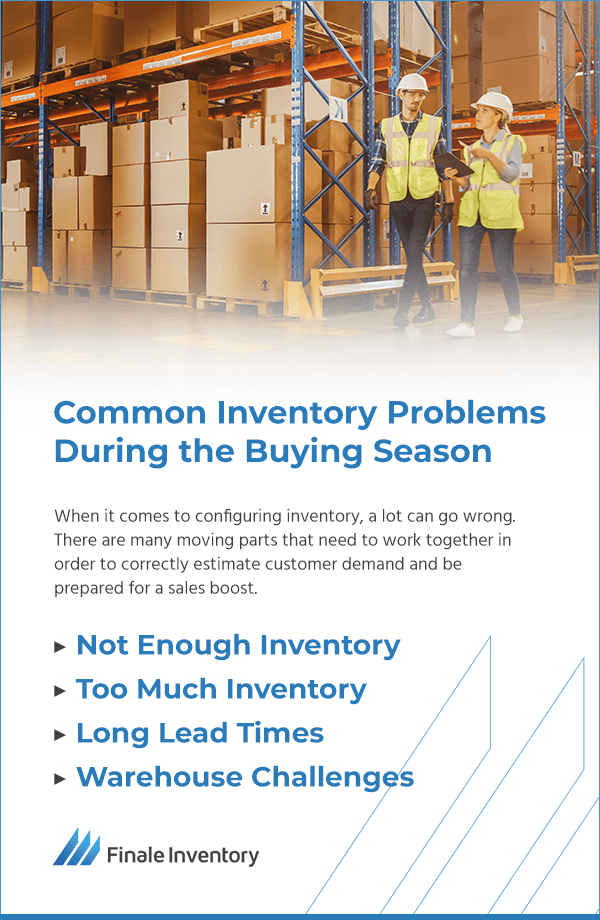
For retailers, preparing for the holiday season can be daunting. Black Friday kicks off a buying season unlike any other throughout the whole year. Did you know that between Black Friday and Christmas, 30% of all sales for the year occur? This uptick in sales means stores must shift their operations during the holiday shopping season if they want to make the most of their inventory.
Having enough inventory for this time of year can prove to be a challenge, especially if your business is tracking and managing stock manually or over multiple platforms. Keep reading to learn about the common inventory problems retailers are faced with at the end of the year.
Common Inventory Problems During the Buying Season
When it comes to configuring inventory, a lot can go wrong. There are many moving parts that need to work together in order to correctly estimate customer demand and be prepared for a sales boost.

1. Not Enough Inventory
Between in-store, wholesale, and online sales, the last thing your business wants to do is experience a stock-out when products are most in demand. At first glance, the thought of selling out of an item may seem like a positive thing for a retailer. However, having out-of-stock items means lost opportunities to make more money.
Stock-outs occur because of the following issues:
- Inaccurate inventory data: When a business does not have an efficient inventory management system, errors are bound to happen. From delayed shipping to manually plugging in stock levels into spreadsheets or other low-tech tools, discrepancies and miscalculations are far more likely than if a retailer opted for inventory management software. Another common problem that causes inaccurate data is not having integration between all retail platforms. To alleviate stock-outs, stores can update the levels of stock regularly to keep numbers as accurate as possible.
- Not re-ordering in time: When a company’s products are selling faster than they are being re-ordered, a stock-out occurs. To understand when and how much inventory should be ordered, a retailer should closely monitor and analyze past sales and consumer behavior. Being able to guess which styles will sell quickly will better equip demand-forecasting efforts. An inventory management software system with reordering capabilities can help a business more accurately interpret when it is time to re-order items so there is plenty in stock for eager customers.
- Communication gaps: When working with multiple warehouses and suppliers, communication can get messy. This can negatively impact stock and re-orders as poor communication can lead to delays and errors. Having established and streamlined channels can combat miscommunication and improve operations since everyone involved is on the same page.
- Poor management: Retailers depend on good management of their people and operations to be successful. When the busy holiday season approaches, stores are forced to shift their processes to better cater to the needs of their customers. Working with management software can efficiently organize inventory counts and analytics to make management simpler.
Having an inadequate inventory level will frustrate and upset consumers, especially during this time of year. It is up to the retail industry to analyze past sales and forecast the right inventory levels for the shopping season so they can make the most sales and keep customers happy.
To combat stock-out woes, retailers should consider inventory management software. Businesses can operate quickly and without error as the software system takes the guesswork out of inventory tracking.
With Finale Inventory, inventory management is integrated into a single seamless platform so your business has everything it needs to succeed in one localized place.
The software is equipped with multi-warehouse inventory management tools that allow you to coordinate stock no matter where it is, even if you work with various warehouses.
Our built-in order management capabilities manage products and utilize smart forecasting tools so you know exactly when you need to reorder stock. Your retail business can curb Black Friday sell-outs with Finale Inventory.

2. Too Much Inventory
On the converse side of having too little inventory, having too much stock is equally as harmful to a retail business. The problem of excess inventory starts when a retailer orders more of a product than what consumers demand. This can leave heaps of inventory sitting in warehouses without much turnover. Having an excess of stock can lead to the following problems for retail businesses:
- Pricey storage costs: Storing excess inventory can be expensive. Between rent, utilities and paying warehouse employees, having lots of products in storage can be a financial burden. Plus, the room that stale inventory takes up leaves less room for products that consumers want to buy.
- Reduced profit margins: When inventory is not selling fast enough, retailers often opt to lower prices to get the products moving quicker. However, the lower prices lead to less profit for the business. In some cases, businesses will mark down stale inventory so low, they sell it for less than what they bought it for, causing losses. In some cases, businesses are forced to donate or throw out inventory that sits too long in the warehouse. This too creates losses for the company.
- Increased waste: In the case of perishable or expired items, having excess stock means increased waste. Unfortunately, if consumers are not buying a product fast enough and the product cannot be donated, it will be thrown into the trash. Items like food or cosmetics with expiration dates cannot be sold, even at discounted prices, and there are few options other than throwing the goods out.
To fight the negative effects of having surplus inventory, retailers should analyze sales and liquidate stock that is not selling quickly enough. Before the hectic holiday season arrives, having promotional deals can promote sales of slow-moving items and make room for Black Friday inventory.
Utilizing Finale Inventory for your holiday season inventory needs can help your business strike the right balance. With advanced multi-warehouse inventory management, retailers can coordinate inventory across all channels and analyze which items are selling and which are sitting. Finale Inventory configures sales velocity and assists with planning reorder points, both of which are vital parts of inventory tracking and management and take the guesswork out of forecasting.
Having a centralized inventory system offers retailers visibility over the many facets of their inventory so your team can manage products from purchase to sale. Order management capabilities can help your brand avoid the costly excess stock before it is acquired.
Make room for the stock that your customers want this holiday season. It is best to rid your warehouses and stores of products that take up valuable space with liquidation and clearance sales. This creates more room in storage and on shelves for items that are more apt to sell. Keep your customers happy by having the right amount of stock this buying season thanks to our inventory management software.
3. Long Lead Times
Lead times in inventory management refer to the length of time between making a purchase order to receiving that order in your warehouse. It is normal for lead times to vary from industry to industry, but the global pandemic has contributed to some of the longest lead times in recent memory. Some of the common causes for these long lead times include the following:
- Delayed shipping: Ports and warehouses are understaffed and moving costs are up 34.5 percent since the beginning of 2021.
- Raw material shortages: The massive uptick in demand after lockdown has led to higher demand than suppliers can keep up with.
- Backlogs: Shortages and high demand are causing orders to go unfulfilled and sometimes even unprocessed.
- Lost products: Having inadequate inventory tracking and management systems leaves room for lost items that lead to lost profits.
- Quarantined and sick employees: COVID-19 has taken its toll on every workforce. Employees that have contracted the virus or were exposed to it are required to stay home. This is causing additional slowdowns at every level of the supply chain.
- Added safety protocols: The additional safety precautions put into place to slow the spread of COVID-19 are taking time away from other business practices and decreasing efficiency in some cases.
- Steep tariffs and national regulations: Tariffs and trade agreements mixed with political tensions are creating longer lead times for components from overseas.
- Miscommunication and errors: Something as simple as a computing error can set lead times back. Having an efficient inventory management system in place is necessary to compact miscommunication blunders.
- Labor shortages: From transportation to manufacturing, companies are having trouble filling important positions. Working with fewer individuals means less efficiency, thus extending lead times. The manufacturing industry, for example, has only filled 60 percent of the jobs lost during the beginning of the pandemic.
- Inclement weather: Hurricanes, flooding, and other severe weather threats can seriously impede the supply chain as it prevents travel and can cause serious damages.
In addition to all of these obstacles, the holiday season adds extra stress to the supply chain as consumer demands skyrocket. This is a recipe for supply chain trouble. You may be asking how you can avoid long lead times despite so many factors that are out of the retailer’s control.
While you cannot change factors like weather or political tension, equipping your business with advanced inventory management software can help curb long lead times. Finale Inventory helps retailers maintain an understanding of lead times and how they impact business processes. Having efficient inventory control will give you an accurate picture of how much stock you have and when you will need to re-order.
Utilize our powerful cloud-based inventory management software to keep an eye on your inventory in real-time and analyze past sales records. Finale Inventory helps your business stay proactive and ahead of your stocking needs. Try to avoid long lead times as much as possible by closely monitoring sales behavior so you can place orders at the appropriate time.

4. Warehouse Challenges
Having enough inventory for the buying season requires warehouses to function and communicate with retailers efficiently. Warehousing issues can be exacerbated by the influx of sales over multiple channels from November through December. Inventory management during the holidays can be extra tricky, especially given additional supply chain problems caused by the pandemic.
Common warehousing challenges during the holidays include the following:
- Predicting order volume: When it comes to Black Friday and the following holidays, predicting consumer demand can be challenging without software to assist you.
- Labor shortages: Warehouses are faced with a unique challenge this season as labor shortages due to COVID-19 are met with a need for additional seasonal help. Warehouses are dealing with the difficulty of having fewer workers and increasing holiday inventories.
- Inefficient processes: With the boost in fulfillment demand, warehouse workers require better processes for coordinating with retailers and moving inventory, especially if they are not utilizing the powers of technology and management software.
- Storing excess stock: A large amount of extra stock can take up valuable shelf space that could be used for other products that sell faster. A retailer can avoid having excess with better demand forecasting and product life cycle. Excess stock can be costly and lead to obsolete items.
- Inefficient picking: When fulfilling orders, human error is common and causes a domino effect of problems for the warehouse. Utilizing wireless barcode scanning can help simplify the picking process for workers and improve efficiency while reducing picking errors.
- Lack of space: Along with storing excess inventory, the busy season can leave little spare room in warehouses and can complicate the picking process. With customer demand data, warehouses can rearrange for the holidays to make picking more efficient and easier.
- Dealing with returns: High volumes of returned products are expected around the holiday season. Warehouses need to be equipped to deal with returning inventories, especially as e-commerce booms and customers are buying online without seeing and feeling goods in person.
Having proper warehouse processes can alleviate some of the holiday stress. With Finale, retailers and warehouses can utilize an integrated warehouse and stock management system that influences smooth operation from order to delivery. Equipped with up-to-date information about real-time sales as well as sales histories, your business will be prepared with the data it needs to make educated decisions on orders.
With our stock monitoring system, every fluctuation in demand is noted. If you use a shipping management system to track orders, Finale can integrate with this to keep a closer eye on all moving inventories.
For retailers that work with more than one warehouse, Finale Inventory offers multi-warehouse inventory management so you can access all of your stock in one localized place. Track inventory movement with wireless barcode scanning capabilities that increase productivity and better manage your products.

Choose Finale Inventory for Your Inventory Management Needs this Holiday Season
If your retail business is wondering how much inventory it will require on Black Friday and the holidays beyond, consider investing in inventory management software. With Finale Inventory, you get centralized inventory and multichannel integrations for seeing where your stock is at across multiple warehouses and over 40 platform integrations.
Equipped with both order and warehouse management capabilities, Finale assists in coordinating your business’s inventory needs so your brand is prepared for the hectic holiday season. Schedule a demo and a Finale Inventory representative will be in touch shortly!





